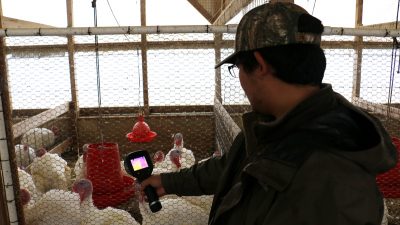BY REBECCA NAGY
As the global population continues to grow, so does the demand for meat products.
This had led to genetic advances in agriculture, including turkey. These genetic lines of turkeys grow faster and leaner than older lines.
“These birds require a high energy diet,” explains Sanjay Shah, professor in the Department of Biological and Agricultural Engineering (BAE). “When they are fed a higher energy diet, they tend to produce a lot of heat.”
Shah and his team are working to help these turkeys keep their cool.

Unfortunately, it can be more difficult for these birds to lose heat compared to smaller birds. To cool the turkeys down, poultry houses use fan ventilation, but setting the correct ventilation rate is important for the performance and welfare of the bird.
“The problem with ventilation is we don’t know exactly how accurately the ventilation affects the birds,” explains master’s student Derek Uemura. Uemura is a BAE graduate student working with Shah on this project.

Shah and Uemura are using a new technique to better understand the effects of ventilation. With the use of infrared cameras, they can see in real-time how turkeys are affected by different ventilation rates.
“Ventilation rates that are too high increase energy use and costs,” Shah explains. “However, ventilation rates that are too low affect the performance of the birds as well as their welfare.”
Optimizing air speeds would reduce both energy usage and cost as well as produce better quality meat.

Infrared imaging could be the key to optimization.
“By using infrared imaging, we get an almost instantaneous result of the effect of what’s going on with the birds,” explains Uemura. “At the end of the day, we want to optimize environmental conditions for the turkeys. When you optimize environmental conditions, you optimize growth and production. You make the customer and the producer happy.”
To accomplish this, Shah and Uemera will compare the effect of different airspeeds on birds in different chambers. To get the most accurate readings, environmental factors such as relative humidity, ambient temperature, and air velocity will all be measured and taken into account.
And it’s all in the name of helping turkeys keep their cool.
This research is funded by The North Carolina Agricultural Foundation. Research partners include co-PI’s Jesse Grimes and Prafulla Regmi from the Prestage Department of Poultry Science.

